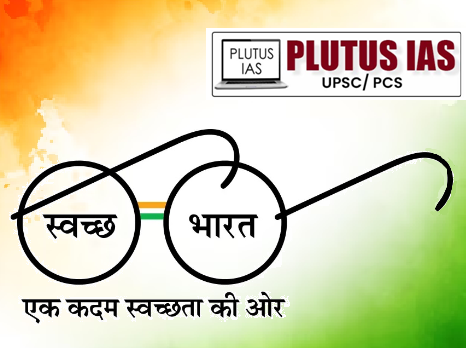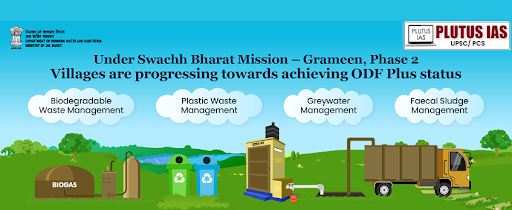07 Sep “Swachh Bharat Mission: Transforming Public Health in India”
This article covers “Daily Current Affairs” and details the topic of the Swachh Bharat Mission and its positive impacts.
Syllabus mapping:
GS-2: Governance: policy and programs in the social sector such as health.
For Prelims:
What is the Swachh Bharat Mission, its key facts, phases, and present implementation, ODF, ODF+, ODF++, etc?
For Mains:
How has the Swachh Bharat Mission changed sanitation and health in rural areas, its impact on various sections of society, and what are the key issues associated with SBM and Wya to make it a national movement?
Why in the News?
A study published in the Nature journal, found that the Swachh Bharat Mission helped prevent 60,000 to 70,000 infant deaths annually from 2011 to 2020. Conducted by researchers from the International Food Policy Research Institute, University of California, and Ohio State University, the study analyzed mortality data from 35 states and 640 districts to assess the mission’s impact on infant and under-five mortality rates.
What is the Swachh Bharat Mission (SBM)?
Prime Minister Narendra Modi launched the Swachh Bharat Mission (SBM) on October 2, 2014, to tackle sanitation issues and make India clean and open defecation-free (ODF) by October 2, 2019. This mission became the world’s largest toilet-building initiative and aimed to transform sanitation practices across the country.

Objectives and Importance:
1. Elimination of Open Defecation: Conversion of unsanitary toilets to pour flush toilets.
2. Eradication of Manual Scavenging: Modernizing waste management practices.
3. Behavioral Change: Promoting healthy sanitation practices among the public.
4. Effective Waste Management: SBM focused on proper waste disposal and management to maintain clean surroundings and prevent the spread of diseases.
5. Raising Public Awareness: The campaign educated citizens about cleanliness, and the impact of poor sanitation, and encouraged active participation in maintaining hygiene.
Components of the SBM:
A. ODF (Open Defecation Free): A locality or area is considered ODF when all households, public places, and community areas have functional and sanitary toilets, and open defecation has ceased
B. ODF+ (Open Defecation Free Plus: ODF+ extends the ODF status by addressing aspects of toilet quality and ensuring that sanitation infrastructure is well-maintained and sustainable.
C. ODF++ (Open Defecation Free Plus Plus): ODF++ goes beyond ODF+ by focusing on advanced sanitation management, including solid and liquid waste management and ensuring comprehensive sanitation coverage.
D. Sustainable Sanitation: Construction of toilets
E. Wastewater Treatment: Including fecal sludge management in smaller ULBs
F. Solid Waste Management: Enhanced processing and recycling
G. Information, Education, and Communication: Public engagement and awareness
H. Capacity Building: Training and development for effective implementation

Swachh Bharat Mission Achievements
| Category | Target achieved |
| Individual Household Latrines | 63.63 Lacs |
| Community and Public Toilets | 6,36,826 |
| Open Defecation Free Cities (ODF) | 4,576 cities |
| Open Defecation Free+ Cities (ODF+) | 3,913 cities |
| Open Defecation Free++ Cities (ODF++) | 1,429 cities |
| Water+ Cities | 64 cities |
Impact of the Swachh Bharat Mission:
1. Improved Sanitation:
Toilet Construction: Over 100 million toilets were built, significantly reducing open defecation.
Reduction in Waterborne Diseases: Increased access to sanitary toilets led to a decrease in diseases like cholera and diarrhea, with notable reductions in disease incidence in ODF districts.
Privacy and Dignity: Access to private toilets enhanced personal dignity, especially for women and girls, addressing safety and discomfort issues associated with open defecation.
2. Economic Impact:
Healthcare Cost Savings: Improved sanitation is projected to save around $4.6 billion annually in India due to reduced healthcare expenses for sanitation-related diseases.
Time Savings: The construction of toilets saved women 30-60 minutes daily previously spent walking long distances to defecate, allowing more time for productive activities.
Employment Generation: The mission created millions of jobs in construction, maintenance, and waste management within the sanitation sector.
3. Community Engagement:
Increased Participation: Over 4,500 cities and towns declared themselves ODF, demonstrating widespread community involvement.
Behavioral Change: Surveys showed about 95% adoption of improved sanitation practices in many areas.
Local Leadership: Local leaders and Panchayats were empowered to manage sanitation efforts, with over 50,000 Panchayats recognized for their exceptional cleanliness and waste management efforts.
4. Environmental Impact:
Waste Management: More than 1,000 cities implemented waste segregation and processing systems, leading to cleaner streets and reduced pollution.
Reduction in Open Defecation: The mission led to a substantial decrease in open defecation, with over 70,000 villages declaring ODF, enhancing cleanliness and reducing environmental contamination.
5. Public Health Improvement:
Health Indicators: Improved sanitation practices led to better public health, including lower incidences of sanitation-related illnesses and decreased child mortality rates linked to poor sanitation.
6. Educational Impact:
School Toilets: The mission’s focus on constructing toilets in over 500,000 schools improved attendance rates, particularly for girls, and fostered a better learning environment.
Challenges Faced by the SBM in the Last Decade
Quality vs. Quantity Focus: Rapid toilet construction often prioritized meeting targets over ensuring quality, leading to usability and longevity issues.
Inadequate Behavior Change Communication (BCC): Insufficient investment in Social and Behavior Change Communication (SBCC) resulted in superficial promotion of sanitation practices without driving deep, lasting change.
Disparities in Implementation: Uneven SBM implementation across states created significant progress variations, with some areas receiving better support than others.
Maintenance and Infrastructure Challenges: Poor maintenance and lack of essential infrastructure, like water supply and sewage systems, led to many toilets becoming non-functional over time.
Cultural Resistance: Persistent cultural norms and attitudes hindered the adoption of improved sanitation methods despite the availability of new facilities.
Inconsistent Monitoring and Reporting: Monitoring and evaluation inconsistencies resulted in misreporting, affecting the credibility of progress and achievements.
Funding Shortfalls: Inconsistent and insufficient funding limited the scope and sustainability of SBM activities, especially in poorer regions.
Limited Training and Capacity Building: Inadequate training and capacity-building programs impacted the effective management and maintenance of sanitation facilities.
Community Engagement Issues: Low levels of community participation and ownership in some areas impeded the long-term success of sanitation initiatives.
Integration with Other Government Schemes: Ineffective coordination with related government programs limited SBM’s ability to address broader sanitation and public health issues comprehensively.
Steps for Advancing SBM and Ending Open Defecation in India
1. Sustaining ODF Status: Continuous monitoring and spot-checking are essential for at least one year after declaring a village, block, or district ODF to prevent reverting to open defecation.
2. Building a Trained Workforce: A trained workforce is necessary to drive behavioral change through participatory processes, educating communities about the health impacts of inadequate sanitation and the benefits of proper facilities.
3. Ensuring Accurate Reporting: Rigorous on-ground verification is needed to prevent over/under-reporting and ensure that reported progress matches actual conditions.
4. Addressing Water Quality Issues: Contamination of open ponds in rural and semi-urban areas poses health risks. Addressing water quality in these areas is vital for improving overall sanitation.
5. Combating Manual Scavenging: Manual scavenging persists despite bans, particularly affecting Dalit communities. Effective technology use and stricter enforcement are required to address this issue.
6. Worker Safety: Sewer workers face hazardous conditions, with about 22,000 deaths annually. Improving safety measures and integrating technology is necessary.
7. Successful Practices: Identifying, documenting, and replicating successful governance practices can enhance sanitation outcomes across regions.
8. Equity: Ensuring equitable planning and access for marginalized SC and ST communities is critical for inclusive sanitation improvements.
9. Improving Excreta Disposal: Proper facilities for the disposal and treatment of excreta are essential to prevent environmental harm and protect public health.
10. Cultural and Mindset Issues: Overcoming cultural barriers and stigmas related to sanitation practices is crucial for long-term behavioral change. Tackling the stigma associated with pit-emptying and encouraging broader toilet use, including by men, is needed for comprehensive improvements.
Conclusion:
The Swachh Bharat Mission has achieved significant progress in sanitation through extensive toilet construction, disease reduction, and community involvement. However, challenges in quality, behavior change, and disparities persist. A holistic approach, including rigorous monitoring, effective communication, and comprehensive support, is essential for sustaining open defecation-free status and further advancing public health and sanitation in India.
Download plutus ias current affairs eng med 7th Sep 2024
PRELIMS QUESTION:
Q. Consider the following statements:
Statement-I: The Swachh Bharat Mission (SBM) has significantly contributed to the reduction of child and infant mortality in the last decade.
Statement-II: The Swachh Bharat Mission elimination of open defecation and effective sustained sanitation in Urban and Rural areas.
Which one of the following is correct in respect of the above statements?
A. Both Statement I and Statement II are correct and Statement II is the correct explanation for Statement I
B. Both Statement I and Statement II are correct and Statement II is not the correct explanation for Statement I
C. Statement I is correct but Statement II is incorrect
D. Statement I is incorrect but Statement II is correct
ANSWER: A
MAINS QUESTION:
The Swachh Bharat Mission has made strides in promoting sanitation. Critically assess how the mission’s implementation has been influenced by socio-cultural factors and suggest solutions to enhance community engagement and sustain behavioral change.
(250 words 15 marks)



No Comments